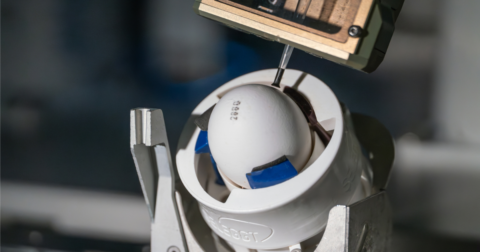News
Could Genetically Engineered Fungus Help Replace Animal Protein?
Breakthroughs•5 min read
News
In-ovo sexing has the potential to spare at least 300 million male chicks each year in the United States from slaughter.

News • Breakthroughs • Science

Words by Grace Hussain
Last week, the egg company Kipster announced that it had successfully implemented in-ovo sexing in its forthcoming flock of laying hens at their facility in Nebraska. The technology enables producers to select and remove male embryos before developing. This eliminates the need for post-hatch culling, where living chicks are commonly ground up en masse. If in-ovo sexing were adopted across the egg industry in the United States, the switch would spare at least 300 million male chicks each year from culling.
In-ovo sexing at scale is possible, but it would result in pricier eggs, though only by a couple of pennies. Still, the price of sexing chicks in-ovo has dropped steadily over the last five years. If cull-free eggs were able to achieve price parity with the competition, in-ovo sexing might then become more widespread.
For Kipster, however, this technology is a temporary solution, as their end goal is to raise both male and female chicks for food. “We’re disappointed that we haven’t yet succeeded in raising male chicks in the U.S.,” said Ruud Zanders, Co-founder and Co-CEO of Kipster, in a press release.
“We see this as a shortcoming on our part — a failure to fully live up to our own vision. But allowing chicks to hatch only to be immediately gassed or macerated — standard industry practice in the U.S. — is simply not an option for us.”
In the U.S., roughly 300 to 350 million male chicks are culled on egg farms annually. Culling is standard practice on most farms because the chicks are viewed as a byproduct of the industry. They’ll never lay eggs and don’t grow large and quickly enough to compete with broiler chickens on the meat market.
“Most consumers are unaware that eating eggs most often means that they’re supporting an industry that grinds up day-old chicks simply because they do not produce eggs,” Kelcie Leach, Manager of Corporate Relations for animal advocacy organization Mercy for Animals, tells Sentient. The nonprofit worked with Kipster closely to support the adoption of the in-ovo sexing technology, Leach says. Other animal protection groups, including The Humane League, have also worked with the company.
Kipster hopes to have in-ovo sexing at all farms by the end of 2027. According to the company, the technology does have a small failure rate that means it will inevitably miss some male embryos, around .5 percent. Those several hundred male chicks will not be culled, according to the press release, but will be sent to a farm where they will be raised for meat, Vijn told Sentient by email. Once all of their eggs are cull-free, the company plans on pursuing welfare labeling through a third party animal welfare certifier, Vijn told Sentient in an email.

When Kipster first launched U.S. operations, they sought to replicate their Dutch operating model: raise hens for eggs and roosters for meat. In the U.S. market, they ran into an issue, however — American consumers. “There’s no market,” Sandra Vijn, who manages Kipster’s U.S. operations, previously told Sentient.
Part of the issue is that consumers in the United States have come to expect very large and relatively inexpensive cuts of chicken, especially chicken breasts — and a lot of them. Factory farms raising chickens specialize in either eggs or meat. Along with farm specialization came birds bred specifically for egg production, and others specifically for meat.
Broiler chickens are bred for swift growth, and as a result they tend to suffer high rates of broken legs or heart issues, while layer hens — including the breed raised by Kipster — can suffer from keel bone fractures.
For now, Kipster’s new flock of in-ovo sexed hens are still chicks. Their eggs will be available in stores starting early 2026, according to the company’s press release.